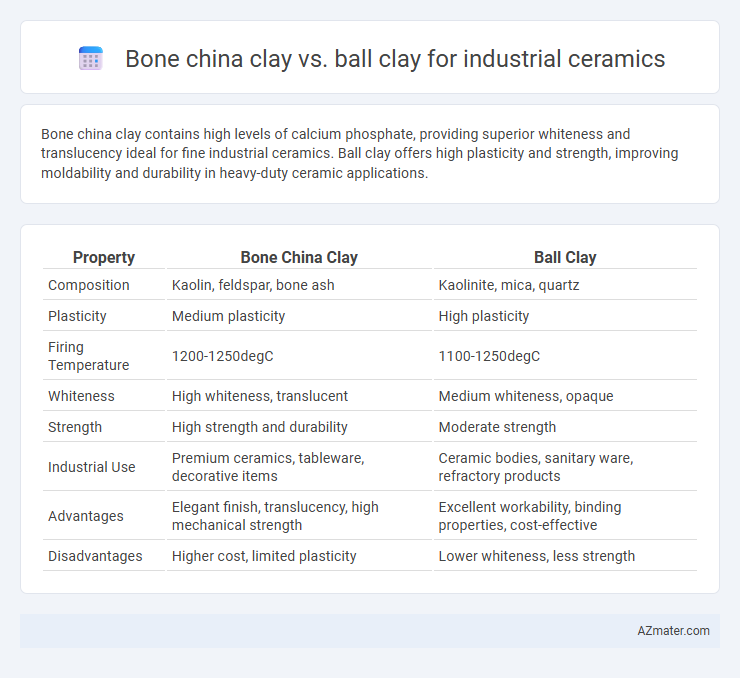Bone china clay contains high levels of calcium phosphate, providing superior whiteness and translucency ideal for fine industrial ceramics. Ball clay offers high plasticity and strength, improving moldability and durability in heavy-duty ceramic applications.
Table of Comparison
| Property | Bone China Clay | Ball Clay |
|---|---|---|
| Composition | Kaolin, feldspar, bone ash | Kaolinite, mica, quartz |
| Plasticity | Medium plasticity | High plasticity |
| Firing Temperature | 1200-1250degC | 1100-1250degC |
| Whiteness | High whiteness, translucent | Medium whiteness, opaque |
| Strength | High strength and durability | Moderate strength |
| Industrial Use | Premium ceramics, tableware, decorative items | Ceramic bodies, sanitary ware, refractory products |
| Advantages | Elegant finish, translucency, high mechanical strength | Excellent workability, binding properties, cost-effective |
| Disadvantages | Higher cost, limited plasticity | Lower whiteness, less strength |
Introduction to Bone China Clay and Ball Clay
Bone china clay contains high levels of bone ash, feldspar, and kaolin, resulting in a strong, translucent ceramic ideal for fine china and delicate tableware. Ball clay features fine particles and high plasticity due to its high kaolinite content, making it essential for shaping and forming industrial ceramics with excellent strength and smooth texture. Both clays play critical roles in ceramic production, with bone china clay focusing on translucency and strength, while ball clay enhances plasticity and workability.
Composition and Mineral Content
Bone china clay primarily consists of kaolin, feldspar, and bone ash, which introduces high calcium phosphate content enhancing translucency and strength in industrial ceramics. Ball clay contains a higher proportion of kaolinite, mica, and quartz, providing excellent plasticity and versatility but lower mechanical strength compared to bone china clay. The mineral composition differences directly influence the firing behavior, whiteness, and durability of ceramic products in industrial applications.
Physical Properties Comparison
Bone china clay exhibits high plasticity and low impurities, resulting in superior whiteness and translucency, essential for fine industrial ceramics. Ball clay possesses excellent plasticity and mineral content with higher iron oxide levels, contributing to strength but lower whiteness. The physical properties of bone china clay favor refined, delicate products, while ball clay suits durable, high-strength ceramic applications.
Industrial Applications and Suitability
Bone china clay, characterized by its high calcium phosphate content and fine particle size, is ideal for manufacturing delicate, high-strength ceramic products such as tableware and electrical insulators due to its excellent whiteness and translucency. Ball clay, with its high plasticity, fine particle size, and strong bonding properties, is preferred in industrial ceramics for applications requiring shaping and molding, including tiles, sanitary ware, and heavy-duty ceramics. The suitability of bone china clay lies in aesthetic and mechanical strength applications, while ball clay excels in structural integrity and workability for mass production.
Mechanical Strength and Durability
Bone china clay offers superior mechanical strength and enhanced durability compared to ball clay, making it ideal for high-performance industrial ceramics. Its unique composition, including calcined bone ash, contributes to improved flexural strength and resistance to chipping under mechanical stress. Ball clay, while providing excellent plasticity and workability, generally exhibits lower mechanical strength and durability, limiting its use in applications requiring robust structural integrity.
Firing Temperature and Thermal Behavior
Bone china clay typically requires a higher firing temperature, around 1200-1250degC, compared to ball clay, which fires at lower temperatures of approximately 900-1100degC. Bone china clay exhibits superior thermal stability and reduced shrinkage during firing due to its unique composition of bone ash, enhancing resistance to thermal shock. Ball clay's high plasticity improves workability but may result in increased thermal expansion and potential warping if not properly controlled during industrial ceramic firing processes.
Workability and Forming Techniques
Bone china clay offers superior workability with its fine particle size and high plasticity, enabling smooth shaping and detailed forming techniques such as slip casting and molding. Ball clay, known for its high plasticity and strength, provides excellent plastic deformation, making it ideal for extrusion and pressing methods in industrial ceramic production. The combined use of bone china clay and ball clay optimizes forming efficiency, surface finish, and mechanical strength in ceramic manufacturing.
Cost Efficiency and Availability
Bone china clay offers superior whiteness and translucency but is generally more expensive and less abundant than ball clay, impacting cost efficiency in industrial ceramics. Ball clay provides excellent plasticity, is widely available, and significantly reduces raw material costs due to its affordability and abundant supply. Choosing ball clay over bone china clay is often preferred in large-scale production to optimize cost efficiency without compromising essential ceramic properties.
Environmental Impact and Sustainability
Bone china clay, primarily composed of kaolin, feldspar, and bone ash, offers a lower environmental impact due to its reliance on natural, biodegradable materials and less intensive mining processes compared to ball clay. Ball clay, rich in plasticity and fine particle size, often requires more extensive extraction, leading to greater habitat disruption and higher energy consumption during processing. Sustainable industrial ceramic manufacturing benefits from bone china clay's reduced carbon footprint and easier waste management, enhancing eco-friendly production.
Choosing the Right Clay for Industrial Ceramics
Bone china clay offers high whiteness, translucency, and strength due to its high calcium phosphate content, making it ideal for premium industrial ceramics requiring durability and fine finish. Ball clay provides excellent plasticity and workability with lower firing temperatures, suited for shaping complex forms in mass production settings. Selecting the right clay depends on balancing mechanical properties, aesthetic requirements, and production methods to achieve optimal performance in industrial ceramic applications.

Infographic: Bone china clay vs Ball clay for Industrial ceramic
 azmater.com
azmater.com